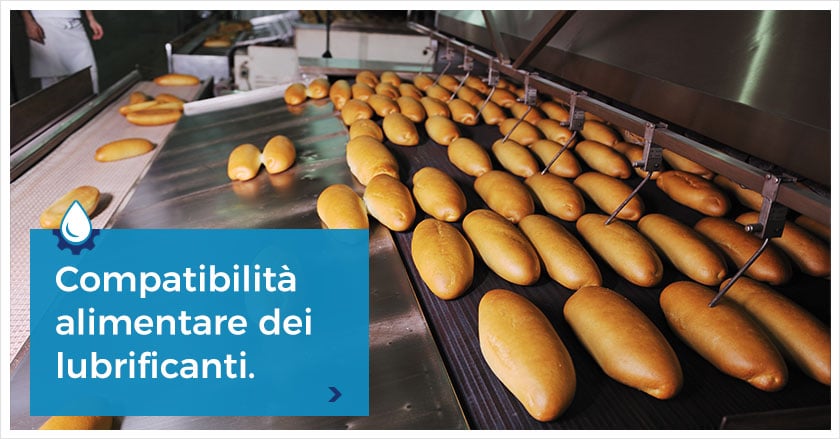
Food compatibility of lubricants
Food lubricants are those which, by their nature and composition, can be used in food production areas, where the risk of contact and contamination of the product (the food) is possible.
To be defined as such, however, it is necessary that the compatibility for food use is absolutely proven and certified according to strict standards.
Basic composition of food-grade lubricants
A traditional lubricant is a chemical compound consisting mainly of a base oil, which is not suitable for contact with food as it would risk contamination.
The use of food-grade lubricants is today necessary, as in industrial food production plants, proper lubrication of the moving mechanical components is vital. At the same time, however, the use of the lubricant increases the chemical risk from contact with the foodstuff produced.
Food-grade lubricants are made using selected raw materials (free of impurities or contaminants from mineral oils). In this sense, it is preferable to use synthetic oils rather than mineral ones because the former guarantee greater purity from contaminants.
Their composition is designed in such a way as to exclude any risk of contamination and damage to the health of the consumer, even if a small amount of these substances does come into contact with the food.
Food lubricants: zero health risks
It is often read that, if ingested or in contact with human skin or mucous membranes, these components can cause serious damage. And it is absolutely true. Yet, we can 100% guarantee that if the lubricants for food use are perfectly certified and comply with the guidelines, a possible small residue in contact with food not only generates no type of health risk for humans but does not even affect the composition or smell of the product.
Food lubricants: certifications
GSFS BRC food-grade certification
When it comes to lubricants, especially in the food sector, the issue of safety for the end consumer is of fundamental importance. For this reason, there are different certifications.
The first is precisely that GSFS BRC that focuses much attention on the risk of internal contamination of the product, emphasising the importance of the use of food-grade lubricants.
GSFS BRC certification also places much importance on the identification, elimination or in any case, on the reduction of the risk of a possible internal chemical contamination, either by direct or even indirect contact.
For example, the use of compressed air to produce the food - even though not requiring direct contact - poses the problem that any traces of lubricant used in the compressor could end up on the food.
Similarly, following the maintenance of the system, it is necessary to ensure that all required hygiene checks are carried out to avoid contamination as much as possible.
The Guidelines for Food-grade Lubricants issued in 2017 by the BRC GSFS then clearly and precisely outlines the evaluation criteria for declaring and certifying lubricants as compatible with food use. The same document even establishes how to use and dispose food-grade lubricants.
ISO 21469 food-grade certification
Finally, at an international level is the specific classification of lubricants for food use: the ISO 21469:2006 standard that differs from that of the NSF International, due to not being limited to an assessment of the composition of the lubricant but also concerns:
- The entire manufacturing/production process (in accordance with the legislation of the country where the food is sold)
- Traceability of the ingredients used
- The hygiene standards maintained throughout the manufacturing process
NSF certification
NSF International has instead classified the lubricants for food use following the categorisation of the chemicals used and judged suitable:- NSF H1-certified lubricants, usable for lubrication applications where there may be accidental contact with food
- NSF HT1-certified lubricants, usable as heat transfer fluid where contact with food can accidentally occur
- NSF H3-certified lubricants, which can be used as a release agent on grills, ovens, pots, cutting boards and so on, to prevent food sticking
Obviously, the harmlessness of food-grade lubricants is closely linked to their use in minimal quantities.
For more information on the composition and certifications of food-grade lubricants, simply request a sample and we will find the ideal lubricant solution for you!
WE HAVE A COMMON GOAL - YOURS!
TOGETHER, WE WILL FIND THE RIGHT LUBRICANT SOLUTION FOR YOU
REQUEST A SAMPLE



